Record Corn Crop Expected
This report summarises the initial USDA supply-and-demand projections and US price prospects for the 2010/11 marketing year. Because planting of spring crops is still under way in the Northern Hemisphere and remains several months away in the Southern Hemisphere, these projections are highly tentative. Projections are based on USDA surveys, economic analysis, judgment, and the assumption of normal weather.
Forecasted feed grain area planted in 2010, based on the 31 March Prospective Plantings, is up 1.7 per cent from 2009. Acres to be planted in corn are expected to be up 2.7 per cent. Total feed grain supplies for 2010/11 are forecast up 1.8 per cent from 2009/10. Even with strong domestic use of feed grains, boosted by a 4.5-per cent rise in corn used to make ethanol, ending stocks are expected to be up from 2009/10. With plentiful supplies of distillers’ grains from ethanol production in 2010/11, feed and residual use is expected lower at 142 million tons for the four feed grains, down from 143 million in 2009/10. Prices are expected to remain strong for all four feed grains but will be down from 2009/10.
Global coarse grain production in 2010/11 is projected to reach a record, up 2.5 per cent from the previous year, with similar increases for area and yield. The largest year-toyear increase is for corn, up 26.5 million tons to 835.0 million, led by increased prospects for China. World coarse grain use in 2010/11 is also projected at a record, up 2.3 per cent from the previous year. Foreign disappearance is projected up 2.6 per cent, with foreign feed use growing 2.1 per cent as the global economic recovery from recession supports increased meat demand. Expanded human consumption is projected for India and Sub-Saharan Africa. This implies that production will be larger than use for a fourth consecutive year, and that the build up in global stocks will be larger in 2010/11 than in 2009/10. Global coarse grain ending stocks are projected to exceed 200 million tons for the first time in more than a decade. World corn trade and US corn exports are projected to expand in 2010/11, but US market share is forecast down slightly.
Domestic Outlook
Feed Grain Production Prospects Up in 2010/11
US feed grain production for 2010/11 is projected at 354 million metric tons, up from 349 million in 2009/10. This year-to-year increase steams from larger projected planted and harvested area for corn, but lower planted and harvest area for sorghum and barley. Oats production is expected to decrease from 2009, with trend yields lower than last year’s record level.
For the four feed grains combined, planted and harvested area is up in 2010/11, but yield is projected lower. Planted area is based on producer intentions reported in the 31 March Prospective Plantings. Harvested area and yield are projected for corn, sorghum, barley, and oats (for more complete descriptions, see the following sections for each commodity). Beginning feed grain stocks are projected at 49 million tons in 2010/11, up from 47 million tons in 2009/10. Total 2010/11 feed grain supply is projected at 405 million tons, up from 398 million in 2009/10.
Feed grain use is expected to increase 2 per cent in 2010/11, with higher projected ethanol production. Feed and residual use is expected to decline 1.1 million tons in 2010/11 to 142 million. Plentiful supplies of distillers’ grains are expected to encourage more feeders to reduce feed grain use. Exports are expected to increase from 54 million tons in 2009/10 to 55 million in 2010/11, as the global economy continues to recover. Food, seed, and industrial (FSI) use is projected at 158 million tons in 2010/11, up from 153 million in 2009/10, nearly all on increased corn use for ethanol. Ending feed grain stocks are projected to increase 1.6 million tons from the 49 million projected in 2009/10. Prices are expected to remain strong but down from 2009/10 and their record highs.
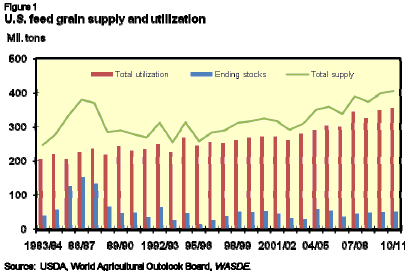
Feed and Residual Use Up in 2010/11
The 2010/11 US feed and residual use for the four feed grains plus feed wheat on a standardized September-August marketing year is projected at 147.6 million metric tons, up just slightly from the previous year. Feed and residual use per grainconsuming animal unit (GCAU) is projected at 1.61 tons in 2010/11, unchanged from 2009/10. Total GCAUs are projected up 0.1 per cent on the year to 91.8 million. GCAUs are expected to be up because of increased production of poultry and pork as demand begins to strengthen in the livestock sector, but lower cattle numbers mostly offset these increases.
The following is a breakdown of animal production forecasts for calendar year 2011:
- Beef production is expected to be 25.1 billion pounds, down from 25.7 billion a year earlier.
- Pork production is projected at 22.7 billion pounds, up from 22.2 billion in 2010.
- Poultry production is forecast at 43.6 billion pounds, up from 42.4 billion pounds in 2010.
- Egg production is expected to be 7.6 billion dozen, up less than 1 per cent from 2010.
- Milk production is expected to be 193 billion pounds, up from 190 billion in 2010.
Changes to 2009/10 Balance Sheets
Changes were made to corn and sorghum for the 2009/10 marketing year. Due to delays in harvesting the 2009/10 corn crop in North and South Dakota, many producers reported corn acres as not yet harvested in the Crop Production 2009 Summary report. These producers were re-surveyed in late April to determine how many of the acres were harvested or still intended for harvest. This resulted in lowering the 2009/10 national average corn yield to 164.7 bushels per acre, down 0.2 bushels from last month. It also lowered estimated production 21 million bushels to 13,110 million bushels for 2009/10, which drops total supply to 14,739 million bushels.
Total use for 2009/10 was raised to 13,055 million bushels, up 140 million from last month. Feed and residual use was lowered to 5,375 million bushels for 2009/10 reflecting increased availability of distillers’ grains. FSI use was revised back to 1997/98 to better reflect net exports of sweeteners and starch as indicated by US Census Bureau data. These changes raise FSI use slightly and lower feed and residual use offsetting amounts. For 2009/10, FSI was raised 165 million bushels to 5,730 million this month. Corn used to make ethanol was increased 100 million bushels to 4.4 billion bushels, reflecting expectations for higher ethanol production in March and April as indicated by weekly gasoline production data from the Energy Information Administration. Exports were raised 50 million bushels to 1,950 million for 2009/10 based on recent strength in sales and shipments. These changes combine with the 21-million-bushel reduction in production to lower ending stocks 161 million bushels to 1,738 million.
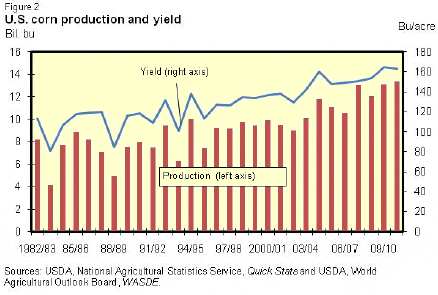
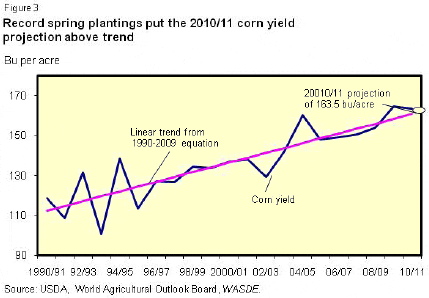
Sorghum exports for 2009/10 were raised 10 million bushels this month to 160 million due to shipments to date to Mexico and Japan. This increase was partially offset by a 5-million-bushel decrease in feed and residual use of sorghum to 135 million. Sorghum ending stocks were also lowered 5 million bushels to 43 million. Oats and barley balance sheets remain unchanged this month for the 2009/10 marketing year.
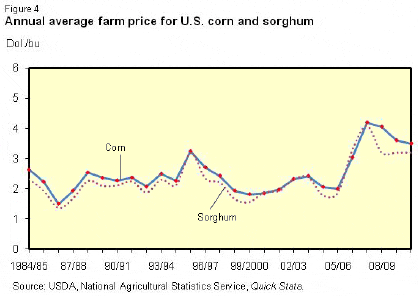
Record Corn Production Forecast for 2010/11
The 2010/11 US corn crop is projected at a record 13,370 million bushels, up 260 million bushels from a year earlier. This year-over-year change stems from a 2.3- million-acre expected increase in planted area to 88.8 million acres as forecast in the March 31 Prospective Plantings report. Harvested acreage is based on estimated demand for silage based on roughage-consuming animal units (RCAU) and historical abandonment. The yield projection is based on the simple linear trend of the national average yield for 1990-09 adjusted for 2010 planting progress.
As of 9 May 2010, 81 per cent of the 2010 corn crop has been planted, which is up sharply from the 5-year average of 62 per cent. The rapid pace of planting is a result of nearly ideal April planting conditions in the major corn production areas.
Beginning corn stocks for 2010/11 are forecast at 1,738 million bushels, up from 1,673 million in 2009/10. Total corn supply is expected to be a record 15,118 million bushels, up 325 million from 2009/10.
Total corn use for 2010/11 is also projected to be record high at 13,300 million bushels, up from 13,055 million for the current year. This year-over-year increase stems from increased exports and FSI use; however, projected feed and residual use is down. FSI use is projected at 5,950 million bushels, up from 5,730 million bushels expected in 2009/10. Increased ethanol production is driving the year-overyear increase.
Exports for 2010/11 are projected at 2,000 million bushels, up 50 million from the previous year. A slow recovery in animal numbers and increased supplies of distillers’ grains are forecast to lower corn feed and residual use in 2010/11. Corn feed and residual is projected at 5,350 million bushels, down from the 5,375 million bushels expected to be used in 2009/10.
Ending stocks of corn for 2010/11 are projected at 1,818 million bushels, up from 1,738 million projected for 2009/10. Season-average corn prices for 2010/11 are projected at $3.20 to $3.80 per bushel, compared with $3.50 to $3.70 per bushel projected for 2009/10.
Food, Seed, and Industrial Use Prospects Up in 2010/11
US FSI use in 2010/11 is expected to increase 3.8 per cent from that of a year earlier. At the projected 5,950 million bushels, FSI will equal 45 per cent of total use, up slightly from an expected 44 per cent in 2009/10 and 41 per cent in 2008/09. High fructose corn syrup use is projected at 505 million, up 5 million bushels from the expected use in 2009/10.
Glucose and dextrose use of corn in 2010/11 is expected to be 250 million bushels, up slightly from 245 million in 2009/10, which was down fractionally from 2008/09. In 2010/11, corn used to produce starch is expected to be 240 million bushels, up 2.1 per cent from expected starch use in 2009/10. As the economy continues to rebound into 2011, demand for construction materials and paper products is expected to strengthen.
Corn use for ethanol in 2010/11 is projected to increase 4.5 per cent to 4,600 million bushels, following an expected 19.7-per cent gain in 2009/10. This increase in corn used for ethanol reflects the rising Federal biofuels mandate and strong blending incentives which continue to boost ethanol usage. Ethanol producer returns, however, will remain under pressure as excess production capacity weighs on producer margins. Monthly ethanol production reported by the US Department of Energy (DOE) was at 833,000 barrels per day in February 2010 (the latest available data), helping boost first-half 2009/10 production to a record 5.9 billion gallons.
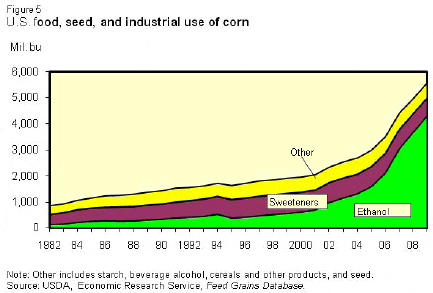
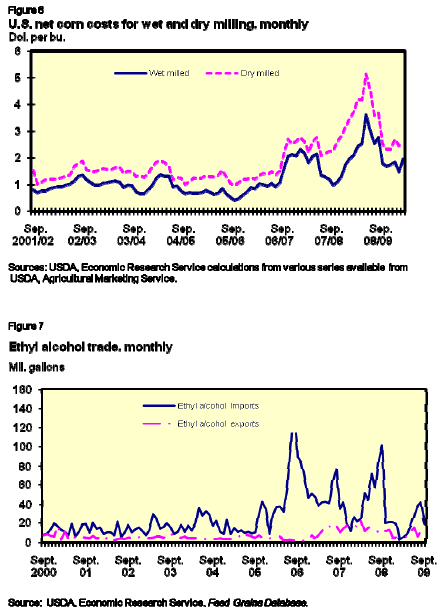
Sorghum Production Prospects Down
The 2010/11 US sorghum crop is projected to be 355 million bushels, down from 383 million in 2009/10. This year-to-year decrease stems from lower planted area and a 3.5-bushel-per-acre decrease in expected yield to 65.9 bushels per acre. Projected harvested area is expected to decline 100,000 acres to 5.4 million. The yield projection is based on a 10-year average (2000-2009, excluding 2002 and 2003), adjusted for rounding in production. Planted area is forecast from the Prospective Plantings report, and harvested area is projected based on the 2005-09 average harvested-to-planted ratio.
Forecasted 2010/11 sorghum beginning stocks are 43 million bushels, down from 55 million in 2009/10. Total supply for 2010/11 is projected to be 398 million bushels, down from 438 million in 2009/10 due to the expected decrease in production and the lower carry-in. Sorghum competes for corn acres in some areas and, often, increasing corn acreage can push sorghum on to more marginal lands, therefore potentially decreasing average yield for sorghum.
Total use is expected to decrease to 355 million bushels in 2010/11 from 395 million projected for the previous year. Feed and residual use for 2010/11 is projected at 115 million bushels, down from an expected 135 million in 2009/10, as tighter supplies and strong demand for ethanol and exports limit feeding. FSI use is projected at 100 million bushels, unchanged from last year. This reflects steady expected use of sorghum for ethanol production. Exports are projected at 140 million bushels in 2010/11, down from 160 million in 2009/10, as lower supplies impact export prospects.
Ending sorghum stocks are projected at 43 million bushels in 2010/11, unchanged from 2009/10, as lower supplies are offset by lower feeding and exports. The 2010/11 season average sorghum price is projected at $2.90 to $3.50 per bushel, compared to $3.10 to $3.30 projected for 2009/10.
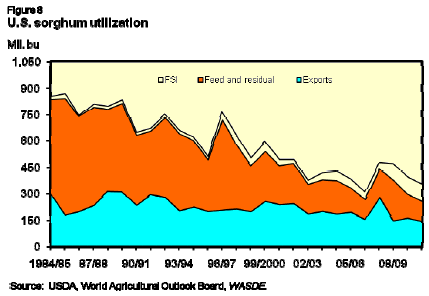
Barley Production Down in 2010/11
The US barley crop is projected at 190 million bushels in 2010/11, compared with 227 million in 2009/10. This decrease comes from lower expected yields and a 294,000-acre decrease in planted area, which is projected at 3.3 million acres in 2010/11. Harvested area is forecast at 2.8 million acres, down from 3.1 million in 2009/10. Barley yield is forecast to be down 6.1 bushels per acre from a record yield in 2009/10 to 66.9 bushels per acre in 2010/11.
Barley planted area is from the Prospective Plantings report, and harvested area is based on the 2005-09 average relationship between harvested and planted area. The barley yield is based on the 1960-2008 trend, adjusted for rounding in production.
Barley beginning stocks are expected to be 116 million bushels, up from 89 million in 2009/10. Imports for 2010/11 are forecast at 20 million bushels, unchanged from last year, as carry-in supplies are plentiful. Total supply is 326 million bushels, down from 336 million in 2009/10. Feed and residual use for 2010/11 is projected at 50 million bushels, unchanged from 2009/10. FSI use is unchanged year-to-year at 165 million bushels, as domestic beer demand is expected to be steady. Exports are projected at 10 million, up from 5 million expected for 2009/10.
Ending barley stocks for 2010/11 are projected at 101 million bushels, down from 116 million in 2009/10. Prices received by farmers for barley are expected to average $3.30 to $3.90 per bushel in 2010/11, compared with $4.65 per bushel in 2009/10.
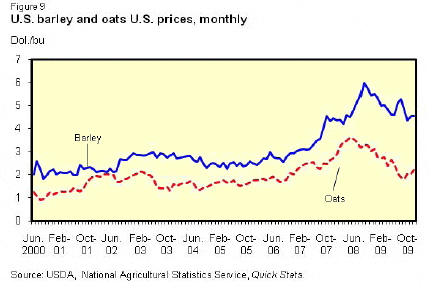
Oats Production Down in 2010/11
US oats production is projected at 90 million bushels in 2010, down from 93 million in 2009/10. This decrease stems from a 40,000-acre decrease in planted area to 3.4 million and lower expected yields. Area harvested for grain is expected to remain unchanged from last year at 1.4 million. Yield is expected to decrease 2.0 bushels per acre from last year’s record to 65.5 bushels per acre in 2010/11. Oats planted area is from the March Prospective Plantings report, and harvested area is based on the 2005-09 average relationship between harvested and planted area. The oats yield is projected based on 1960-2008 trend, adjusting for rounding in production.
Forecast oats beginning stocks are 84 million bushels for 2010/11 unchanged from 2009/10. Imports are projected at 100 million bushels, up 5 million from the previous year, with large expected supplies in Canada. This puts total 2010/11 oats supply at 274 million bushels, up slightly from 272 million in 2009/10.
Total 2010/11 oats use is projected at 194 million bushels, up from 188 million expected in 2009/10. Feed and residual use is projected at 115 million bushels, up 5 million from expected use in 2009/10. FSI use is projected at 76 million bushels, up slightly from 2009/10. Exports of oats are projected at 3 million bushels, also unchanged from the previous year. Ending stocks are expected to be 80 million bushels, down from 84 million in 2009/10. Oats prices are projected at $1.80 to $2.40 per bushel, compared with $2.02 per bushel projected for 2009/10.
Hay Stocks Down in 2009/10
US hay stocks on 1 May 2010, totaled 20.9 million tons, down 5 per cent from a year ago. Disappearance from 1 December 2009 - 1 May 2010 totaled 86.3 million tons, compared with 81.6 million tons for the same period a year ago. RCAUs for 2009/10 are down 1.6 per cent. Hay disappearance per RCAU for the 2009/10 marketing year (May-April) is up 2.43 per cent from the 2.06 tons per RCAU consumed in 2008/09.
Silage production in 2009 was down 4.6 per cent, and, together, hay supply plus silage per RCAU was down 1.3 per cent from the previous year. Farmers in March indicated they plan to harvest 60.46 million acres of hay in 2010, up slightly from 2009.
Hay stocks increased in the Tennessee Valley, Ohio Valley, Rocky Mountains, and much of the Southwest. Stock increases in these areas were largely attributed to improved spring pasture conditions and, in many cases, higher 2009 hay production. Stocks in Kentucky and Rhode Island showed the largest increases.
Hay stocks were down in the southern Great Plains, Mississippi Valley, Great Lakes, Delta, and most Atlantic Coast States. A harsh, snowy winter in many States in these areas caused hay stocks to dwindle as producers were forced to feed more hay due to the lack of available winter pastures. Hay stocks were also lower compared with 1 May 2009, in California, Washington, and Utah. Overall, the greatest per centage declines occurred in Alabama, Mississippi, and Texas.
Given estimated livestock numbers, current pasture and range conditions, and hay stocks, prices are expected to remain strong in the 2010/11 hay marketing year but down from record highs in 2008/09. The weighted average of all hay prices from May 2009 to April 2010 was $111.00 per ton, compared with $152.00 per ton during the same period a year earlier.
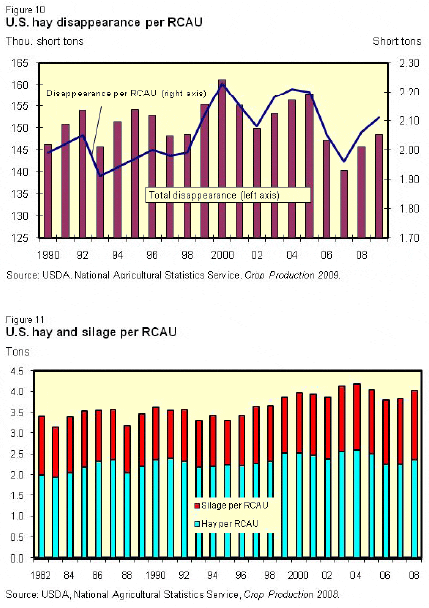
International Outlook
Record World Coarse Grain Production Projected in 2010/11
Global coarse grain production in 2010/11 is projected to reach a record 1,129.8 million tons, up 2.5 per cent from the previous year. World area harvested is expected to grow 1.3 per cent to 310.8 million hectares, while average yield is projected up 1.2 per cent to 3.64 tons per hectare.
The largest year-to-year increase in 2010/11 is for corn, up 26.5 million tons to 835.0 million, led by increased prospects for China. World millet production over the same period is forecast up 5.0 million tons to 32.4 million, as a normal monsoon season in India facilitates a rebound in production. Global sorghum production is projected up 3.5 million tons to 63.4 million due to a modest increase in both area and yield. World oats production is projected slightly higher at 24.5 million tons as area is expanding enough to offset a slight reduction in projected yields. World barley production is forecast down 5.8 million tons to 143.0 million as low prices and meager returns in most major producing countries favor other crops. Rye area is also down, cutting world production 1.5 million tons to 15.8 million. Mixed grain (mostly triticale) production nearly mirrors rye, down 0.6 million tons to 15.7 million.
The largest foreign coarse grain producer is China, with projected production of 173.0 million tons in 2010/11. Corn production is forecast up 11.0 million tons over the same period to 166.0 million. Corn area is expected to increase 1.0 per cent as corn prices in China and government programs encourage some expansion. Corn yields are projected up 5.7 per cent as assumed normal weather brings a return to trend yields, following last year’s drought in some key provinces. Increased area and yield are projected for barley, boosting production 0.6 million tons to 3.1 million as some brewers increase use of domestic production. There is a slight increase expected for sorghum yields and production.
EU coarse grain production in 2010/11 is projected to decline 1 per cent to 149.8 million tons. The largest decline is for barley, down 2.0 million tons to 59.4 million, due to unfavorable returns compared to other crops, especially rapeseed and wheat. EU area and production are also projected lower in 2010/11 for mixed grains, rye, oats, and sorghum. However, corn planting remains relatively profitable, so area and yield are forecast up from the previous year, boosting production 1.5 million tons to 57.0 million.
Brazil’s coarse grain production in 2010/11 is forecast down 2.3 million tons to 53.7 million. This corn crop will not be planted till late 2010, as the 2009/10 crop is still being harvested. First-crop corn is expected to continue to lose area to soybeans and other crops, with only a partial offset from expanding second-crop corn. Moreover, yields are not expected to match the previous year’s record. Small increases are projected for sorghum and barley in 2010/11.
India’s coarse grain crop in 2010/11 is expected to rebound strongly from the previous year which was affected by a subpar monsoon, with production increasing 21.7 per cent to 40.6 million tons. Millet area is expected to increase 17.6 per cent, with smaller increases for sorghum and corn. Yields are expected higher year to year for rainy-season crops, especially millet and corn.
Mexico’s coarse grain production is forecast up 14.0 per cent in 2010/1, as rainfall was below average across the main corn areas in the previous year. Corn area is projected to rebound to near the 2008/09 level. Sorghum area is not forecast up as strongly, but improved yields are expected.
Russia’s coarse grain production is forecast down 4.1 per cent in 2010/11 to 30.5 million tons, as reduced area for barley and rye more than offset increases for corn and oats. Sunflowers, corn, and wheat are expected to have better returns for producers than barley.
Nigeria is projected to produce 28.1 million tons of coarse grain in 2010/11, up slightly from the previous year due to a small expansion in forecast sorghum area.
Argentina’s coarse grain production is projected to reach 27.1 million tons in 2010/11, up 1.7 per cent over the previous year. Increased corn, sorghum, and barley area is expected as planting conditions are expected to improve with normal soil moisture, compared with the dry planting conditions in the previous year. Trend yields are a decline from the previous year for corn and sorghum, but an increase for barley.
Canada’s coarse grain production is projected up 7.7 per cent in 2010/11 to 24.1 million tons. A rebound in corn yields and expanded oats area are expected to more than offset declines for barley and rye.
Ukraine’s coarse grain production is projected to reach 23.5 million tons in 2010/11, down 2.8 per cent from the previous year. Reduced area for barley, rye, and oats is expected to more than offset a small increase in corn area.
South Africa’s coarse grain production is forecast down 10.3 per cent in 2010/11 to 13.0 million tons. Corn area is expected to decline as prices reflect large stocks from bumper crops in the previous 2 years. Trend yields also are somewhat lower than in recent years.
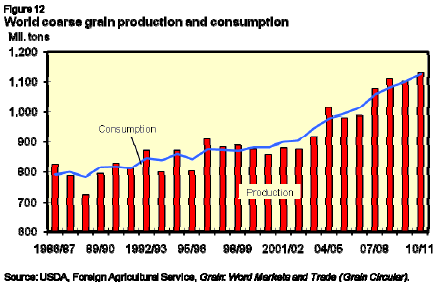
Coarse grain production in the Middle East is projected up 12.1 per cent to 19.7 million tons in 2010/11 as favorable winter rains and mild winter temperatures across most of the region boost prospects, especially for barley. However, coarse grain production in North Africa is projected down 12.9 per cent to 13.4 million tons. Winter rains were above average in Morocco, but were not as abundant as the previous year, and disease problems are reportedly more prevalent. Southern growing areas in Tunisia suffered from drought.
Global Coarse Grain Beginning Stocks Slightly Higher in 2010/11
World beginning stocks of coarse grain in 2010/11 are forecast up 1.6 per cent to 196.7 million tons over the previous year. Foreign stocks are up only 1.1 million tons to 147.7 million. The EU and Argentina are estimated to have increased coarse grain stocks during 2009/10, while Mexico and Canada reduced. EU barley stocks are up 4.1 million tons to 15.0 million in 2010/11 as low prices and prospects for the end of intervention provide a strong incentive for producers to offer barley into intervention.
Record Coarse Grain Use in 2010/11 To Limit Stocks Increase
World coarse grain use in 2010/11 is projected at a record 1,125.0 million tons, up 2.3 per cent from the previous year. Foreign disappearance is projected up 2.6 per cent to 824.5 million tons, with foreign feed use growing 2.1 per cent to 515.7 million as the global economic recovery from recession supports increased demand for meat. Industrial use of corn in China is projected up as much as feed use (each up 2.0 million tons). In the EU, coarse grain use increases are expected to be split between both feed and industrial use, as ample supplies of coarse grain and competitive prices allow the crop to compete successfully with low-quality wheat. In Brazil, the growth in coarse grain use is expected to be in feed use. Most of the 16-per cent increase in India’s coarse grain use in 2010/11 is expected to be expanded human consumption. Expanded human consumption is also expected to be the main driver of increased use in Sub-Saharan Africa.
Global Production Higher Than Use To Boost Ending Stocks
World coarse grain production is projected to grow 2.5 per cent, slightly faster than use at 2.3 per cent. This implies that production will be larger than use for a fourth consecutive year, and that the buildup in global stocks will be larger in 2010/11 than in the previous year. Global coarse grain ending stocks are projected to exceed 200 million tons for the first time in the last decade. However, the increase in global stocks of 4.8 million tons to 201.5 million is modest and is expected to be concentrated in China.
China has been pursuing a policy of supporting prices, area, and production of coarse grain, mostly corn, in order to support rural incomes and limit rural-urban migration. This has led to increases in estimated stocks for 4 of the last 5 years. However, in 2009/10, drought in parts of Northeast China, the most important corngrowing region, reduced production and caused a small decline in estimated stocks. In 2010/11, a return to normal yields and continued large corn area are expected to cause a rebound in production, boosting coarse grain ending stocks 7.0 million tons, to 61.0 million. China stocks are projected to be the largest in the world for the third straight year.
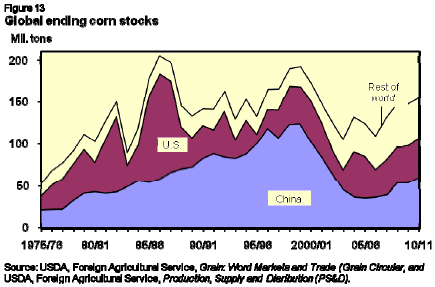
Several foreign countries are expected to have increased production of coarse grains in 2010/11, causing an increase in projected ending coarse grain stocks. The most important are Mexico, up 1.6 million tons; India, up 0.8 million; Argentina, up 0.7 million; Syria, up 0.6 million, Paraguay, up 0.5 million; and Canada, Algeria, and Ethiopia, each up 0.3 million.
The largest anticipated declines in coarse grain stocks in 2010/11are for Brazil, down 3.2 million tons as production declines and use increases; the EU, down 1.4 million; the former Soviet Union and South Africa, each down 1.0 million; Australia and Indonesia, each down 0.4 million; and Tunisia, down 0.3 million.
World Coarse Grain Trade Projected Up in 2010/11
Global coarse grain trade in 2010/11 (October-September trade year) is projected to reach 113.6 million tons, up 3.8 million tons from the previous year. Corn trade is projected up 4.6 million tons to 89.3 million. Barley trade is expected to contract 0.5 million tons with smaller reductions for sorghum and rye trade. Oats trade is projected slightly higher.
The largest increase in corn imports during 2010/11 is projected for Mexico, up 1.1 million tons to 9.1 million. Mexico’s meat production is projected to grow with a recovery in macro-economic growth, and imports are expected to grow to replenish stocks to normal levels. South Korea is projected to increase corn imports 0.8 million tons to 8.6 million, as corn prices are expected to be more attractive than low-quality wheat prices. Canada’s corn imports are forecast up 0.5 million tons to 2.5 million to meet recovering feed use, support expanding industrial use, and to replenish stocks. An expanding poultry sector is expected to boost Egypt’s corn imports 0.4 million tons to 5.4 million. Increased meat production is expected to support corn import increases of 0.3 million tons each for Brazil (to 1.0 million) and Malaysia (to 2.8 million). Several countries are expected to have smaller increases in corn imports. Japan is expected to remain the largest corn importer, stable at 16.3 million tons.
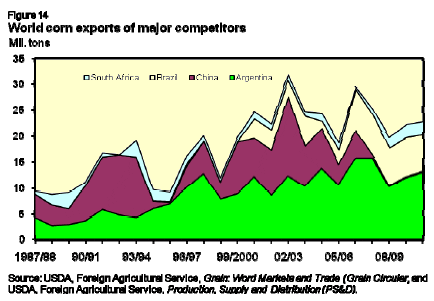
Competition among corn exporters is expected to remain intense in 2010/11, with US exports increasing 2.0 million tons to 51.0 million, but with the US share of world corn trade slipping slightly from 58 per cent in 2009/10 to 57 per cent. Argentina is projected to be the second largest corn exporter, up 1.0 million tons to 13.0 million as production expands. India, with increased corn supplies, is expected to see a recovery in corn exports, doubling to 2.0 million tons. Large corn supplies in Serbia and South Africa are expected to support corn export increases of 0.5 million tons each in 2010/11. The only corn exporter with a significant decline projected for 2010/11 is Thailand, down 0.3 million tons to 0.7 million due to strong demand from its poultry sector.
US corn exports for 2009/10 are boosted 1.0 million tons this month to 49.0 million based on the strong pace of recent sales and shipments. From October 2009 to March 2010, Census corn exports reached 22.4 million tons, up 7 per cent from a year earlier. Export sales shipments during April 2010 indicate exports of about 4.3 million tons, up 13 per cent from a year ago. Outstanding corn sales at the end of April were also up 13 per cent. US exports and sales for 2009/10 are expected to slow when Argentina provides additional export quota to exporting companies and the Brazilian government begins to subsidize the movement of corn to exporting regions.
US sorghum exports for 2009/10 are increased 0.3 million tons this month, as the pace of sales and shipments to Mexico and Japan has been strong. However, sorghum exports later in the year are expected to be limited by tight US supplies.
Further Reading
| - | You can view the full report by clicking here. |
May 2010


